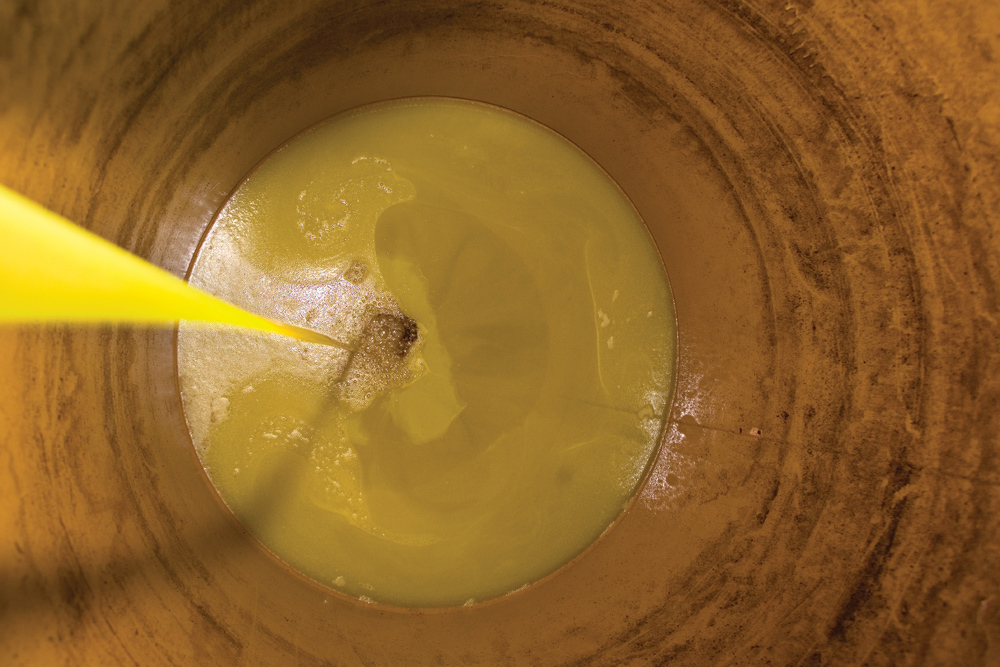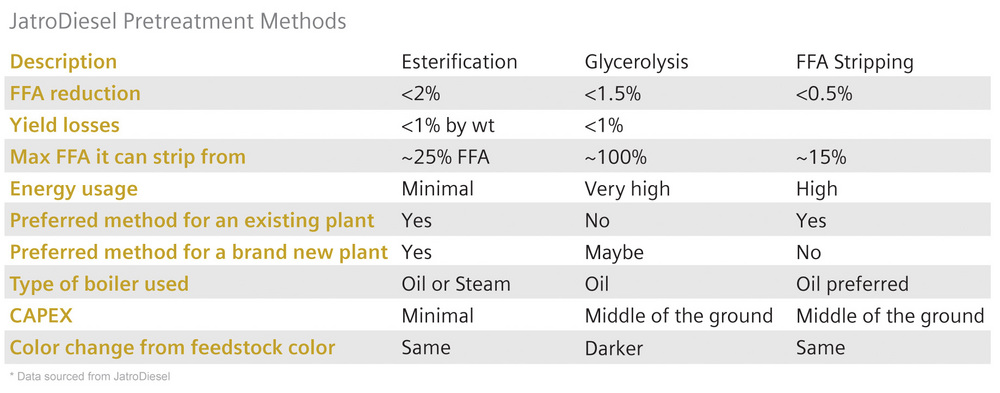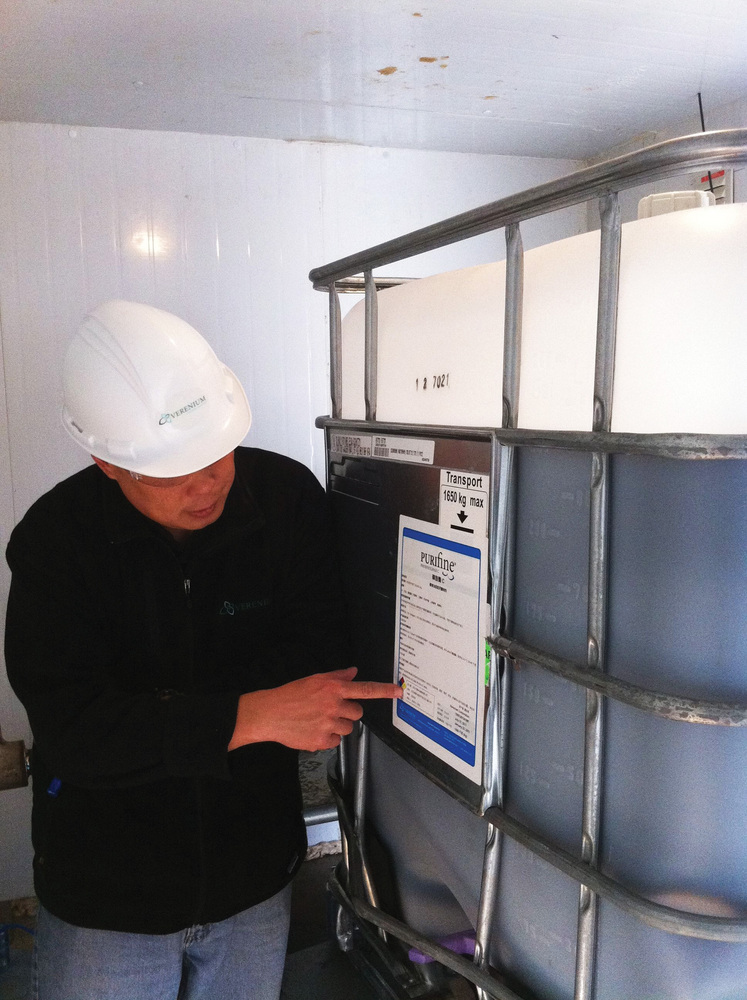A Critical Component




January 18, 2012
BY Erin Voegele
A wide variety of feedstock pretreatment materials and technologies is readily available in the marketplace. From steam stripping, to acid esterification, glycerolysis, enzyme pretreatment or even adsorbents, biodiesel producers have a number of options to consider and vet for possible implementation at their facilities.
Each method clearly has its relative advantages and drawbacks when compared to other technologies and materials available to the industry. Not all pretreatment methods are appropriate for a given plant, however. In most cases, economic considerations coupled with feedstock characteristics and plant design will be driving forces in the final selection of a pretreatment solution.
While existing plants can be retrofitted with new equipment and pretreatment systems to allow more feedstock flexibility, Klaus Ruhmer, BDI-BioEnergy’s business development manager for North America, cautions producers not to think of pretreatment solutions as some sort of magical “black box.”
“We are often approached by customers who have an existing facility designed to process virgin vegetable oils,” Ruhmer says. They want to be able to take in lower-cost, lower-quality feedstocks, such as waste cooking oil. Oftentimes, those producers are looking for some sort of magic device, Ruhmer says, that can turn these lower quality feedstocks into something suitable for their existing plant. There is no magic black box of a solution, he says. “An efficient pretreatment solution has to be integrated with the rest of the plant,” Ruhmer says. “It can never be looked at as a standalone solution.” Rather, pretreatment solutions should always be considered an integrated component of a plant, and one that is designed to make plant operations more efficient and economical. “The ultimate thing about the biodiesel business is really to maximize yields,” he says. “You can always take a feedstock and remove the free fatty acids and make biodiesel. It’s not a question of [whether] you can make biodiesel; it’s how much biodiesel you can make out of a given feedstock stream, because margins are razor thin.”
Raj Mosali, president of JatroDiesel, adds that the ability to be feedstock flexible has almost become a mandatory requirement for a plant to be profitable and successful. For this reason, he says, the future looks bright for pretreatment technologies. He also stresses that existing processes and technologies should be more than capable of handing the needs of new feedstocks, such as pennycress and camelina, as they become more widely available. “Primarily any technology that works with the existing and commonly available chemicals has a good future,” he says. “Anything that needs a customer or plant to buy new chemicals or enzymes is a tough sell.”
Fighting FFAs
Advertisement
The presence of FFAs in biodiesel feedstocks is a chronic problem, says Jon Van Gerpen, professor and department head of biological and agricultural engineering at the University of Idaho. The problem is made more complex by the fact that feedstocks can contain FFA levels as low as 0.5 percent, or as high as 100 percent. While at least a half dozen solutions are available to reduce these FFA levels, most are only effective and economical with a relatively small range of FFA levels.
“For example, if you have an oil that has 10 percent free fatty acids in it, the distillation approach—or the steam stripping of fatty acid approach—works very well,” Van Gerpen says. “It’s natural in that range of [10 to 15 percent] free fatty acids. If you only have 1 or 2 percent free fatty acids in your oil, that has been a real challenge because it’s high enough free fatty acids that you are going to have problems with high soap formation during your reaction. You’d like to have some recourse to deal with that, but most of the other technologies [are equivalent to] hitting that problem with a sledge hammer. They are really expensive, they are really high technology and they are energy intensive. They just cost too much.” In those cases, materials like adsorbents can make much more economic sense.
According to Masali, JatroDiesel currently offers three different types of pretreatment methods designed specifically to deal with FFAs, including acid esterification, a glycerolysis process known as MGEN, and FFA stripping. He notes that his company has also assessed enzymatic technologies developed by third parties to reduce FFAs. Although those enzymatic solutions work well in the lab, he says they still face some technical issues when it comes to implementing them on an industrial scale.
When considering the need for a pretreatment technology, Masali recommends that biodiesel producers first consider how their existing production system works. That alone can drive which method to use, he says. Second, producers also need to consider what their primary feedstock will be over the long term, and the FFA level of that source. Existing plants also need to consider what type of existing equipment is onsite and how the pretreatment technology ties into those systems.
While each process may have its own unique range of FFA levels it is most appropriate for, each solution also has challenges that must be considered. Although Van Gerpen stresses that adsorbents can be very effective when dealing with low levels of FFA, generally up to 2 percent, he also notes that the method results in a fairly significant amount of waste material that a producer will need to deal with. “The adsorbents are extracting the free fatty acids out and adsorbing those free fatty acids into the powder,” he says. “That powder then needs to be disposed of, and typically you do that by putting it into a landfill.”
Acid esterification also results in a significant amount of waste. Although the method can effectively deal with fatty acid ranges a high as 100 percent, Van Gerpen notes that the disadvantage is that you are working with concentrated sulfuric acid at the facility. “Ultimately, that sulfuric acid has to be neutralized and disposed of,” Van Gerpen explains. “You end up with a waste stream there. The acid esterification is a very versatile technology, but it does involve handling more hazardous materials than certain biodiesel producers might be comfortable with.”
When it comes to enzyme treatments for FFA reduction, Van Gerpen seems to agree with Masali’s assessment. “They are limited by most of the same factors as acid esterification, except they tend to be slower and they are still constrained by things like chemical equilibrium,” Van Gerpen says.
Advertisement
Removing Impurities
While enzymes might not be currently considered the most effective solution to reduce FFA levels in a feedstock, enzymatic solutions can be a highly effective means to reduce impurities like metals. Verenium Corp. offers one such product that is specifically designed to remove phosphorous from vegetable oils, predominantly soybean oil. The product, Purifine phospholipase C (PLC), was originally developed for use with edible oils, but is also an effective way to lower the phosphorous levels of feedstock destined for conversion into biodiesel. Although other enzymes on the market can actually increase the FFA level of feedstocks as a side effect of the degumming, Verenium Chief Operating Officer Janet Roemer stresses that is not the case with Purifne PLC.
“One of the primary benefits of our product is that it actually [achieves] an increase in the yield of oil from the degumming step,” Roemer says. “Some of the oil that would otherwise be lost in that step is redeemed using our product. It’s really a very nice economic boost for the plant.” She also notes that feedback Verenium has received from plant operators indicates that the use of enzymes can make products flow more effectively through the conversion process of a plant.
According to Van Gerpen, adsorbents can also be used to effectively remove phosphorus. While there are less expensive methods to do so, especially if a plant is willing to buy a degumming system, he says that adsorbents can offer additional flexibility to facilities that usually take in low phosphorous oils as feedstock. “If you are a producer that is normally buying low phosphorous oil, but you have access to buy a load of low-cost oil that still had some phosphorus in it that has not been degummed, you could use an adsorbent on a discretionary basis to take advantage of opportunities that might arise in the marketplace,” he explains.
The presence of sulfur is another area in which pretreatment solutions would be beneficial. Van Gerpen says that his group has been working to identify an adsorbent that would be effective in reducing the sulfur level of a feedstock. “Typically when people are starting out with an oil that is high in sulfur, they have to distill the biodiesel to reduce the sulfur content,” Van Gerpen says. The process would be much simpler if an adsorbent were available that could effectively reduce the sulfur level of a feedstock.
Chris Abrams, general manager of the Dallas Group, notes that Magnesol 600R is just one product in his company's R series of adsorbents. Different adsorbents in that line are designed to remove a broad range of contaminants from oils, esters and surfactants. “What it removes are predominantly metals, especially phosphorous and sulfur,” Abrams says, “but they also pick up soaps, sterol glucosides, polymers, and polyethylene. They increase oxidative stability of the feedstock, and they also can remove free fatty acids, which is what 600 R is specifically designed to do.” He says by using the product on feedstocks with FFAs, producers can remove that material and will not have to address that either with acid pretreatment or as a soap from transesterification. “With adsorbents, you get a broad range of removal,” he says. “There are some pretreatment options that specifically address acid, some specifically address soaps…but with the adsorbents you can remove a broad range. You really get the full spectrum of contaminants that could affect the quality of your fuel.” Abrams stresses, however, that the use of adsorbents is really an economic consideration. “If you have grossly contaminated feedstock, then our products become less viable,” he says.
“We’d love to find something that was really effective for sulfur,” Van Gerpen says. “That’s kind of the Holy Grail right now, to find an adsorbent that will pull the sulfur out. We have had fairly good success looking at things that could take out phosphorous and some calcium and magnesium, those types of materials, but not very good luck with sulfur. And sulfur is the one that we really need.”
Author: Erin Voegele
Associate Editor, Biodiesel Magazine
(701) 540-6986
evoegele@bbiinternational.com
Upcoming Events





